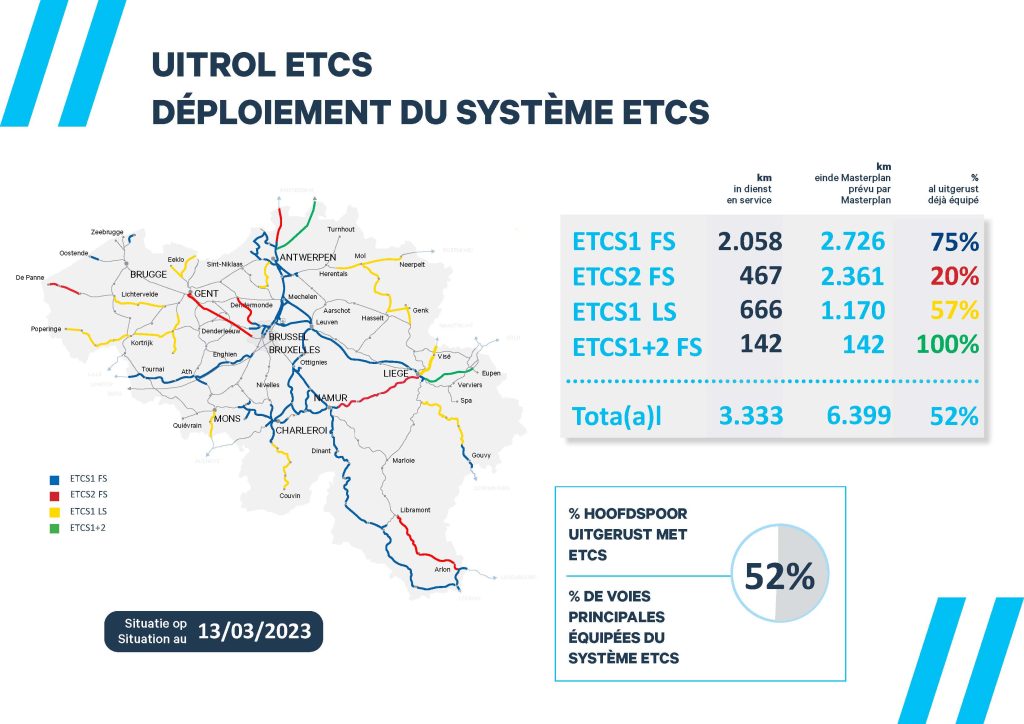The Netherlands and Belgium are neighbours yet so far in ERTMS rollout

Belgium prides itself that 52 per cent, or 3,333 kilometres, of its national railway network, is equipped with ETCS. Across the border in the Netherlands, by contrast, ‘only’ four lines are currently under ERTMS. Indeed, both countries take vastly different approaches to the rollout of ETCS. Infrastructure managers ProRail and Infrabel provided their comments on the situation.
The rollout of ETCS in Belgium continues unabated, and in the remaining eight months of the year, another 670 kilometres of track will be equipped with the technology. The Dutch, too, have a plan. But they’re also taking a longer horizon. In the coming 6,5 years, another eight lines are due to be equipped with ETCS, along with the regional lines in the North of the country. This is part of the Netherlands ERTMS strategy for 2030.
The Belgian network features a mix of ETCS Level 1, Level 1 Limited Supervision and Level 2. This mix is “far too complex”, the ERTMS directorate in the Netherlands recently told SpoorPro. “A similar strategy simply would not work with our approach. It would only slow us down. The pace of the rollout in Belgium, in fact, dictates systems with a lower level of functionality”, a spokesperson said. The complex mix adopted in Belgium has created a patchwork that is causing difficulties, the Dutch claim.

‘The Dutch have more time’
Infrabel, unsurprisingly, disagrees. Spokesperson Fréderic Petit said both strategies and approaches come with their own distinct advantages and disadvantages. The Belgian context dictated that they jump right out the gate. “This harks back to the 2010 train distaster near Buizingen that left 19 people dead. There was a clear desire to improve safety: via the automatic train protection system TBL1, but also by means of latching on to the European ERTMS deployment plan and install ETCS both track side and on board.
The Dutch say that their automatic train protection system ATB still functions just fine, which removes the urgent need to begin replacing it based on grounds of safety. “We simply have more time than our neighbours in Belgium”, the directorate said. That does not mean that the Dutch do not wish to speed up. To that end, the ASAP ERTMS was established, with the goal of arriving at fresh solution to fast track the rollout.
‘Logical compromise’
The Masterplan ETCS through 2025 that Infrabel and SNCB developed is a “logical compromise”, Petit says. “This mix of systems enabled us to increase the safety op train operations quickly and cost-efficiently.”
Infrabel adopts ETCS L1 FS based on the following criteria: when such a project was already planned or set in motion prior to the development plan, like on freight corridor 2 coming out of Antwerp, or when ETCS L2 FS is not technically feasible. This can be the case at major station. Another criterium is the short sections of track between ETCS L1 FS zones.
On all other tracks, L2 FS is installed The only exception being less busy tracks, where the choice falls on ETCS L1 LS. Infrabel stresses that its Masterplan allows for a tailored, case-by-case approach. They also note that 2025 is certainly not the end date for its ETCS plans. The infrastructure manager will continue to modernise and upgrade is network in line with the federal government’s Rail Vision 2040, and to switch to ETCS L2 FS.
“Basically, the process of simplification will begin from 2025 onwards. We’ve always made the installations based on our needs, and in places we also simply don’t need full functionality. Put differently, we won’t wait until 2030 to reap the rewards from ETCS, and in doing so we accept the additional challenges along the road”, Petit notes.
This article originally appeared on our sister publications RailTech.be and RailTech.com.
Also read:





